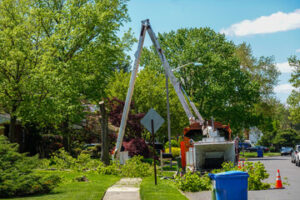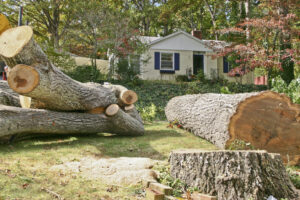From keeping your property clean to preventing damage during storms, there are many reasons why you may need to remove a tree. Tree service professionals can thin overcrowded trees, trim trees that are close to power lines, or even remove a tree if it is in danger of falling down.

Professional Tree Removal Service will follow specific safety precautions to keep you and their crew safe. This may include a detailed assessment of the tree and surrounding area, clearing the area around the trees, securing any structures within reach, and using equipment to remove large branches safely. A professional tree removal company will also carry insurance, which protects homeowners from onsite accidents and property damage. It is best to ask for proof of insurance before hiring a contractor.
When choosing a name for your Tree Removal Service, it is important to choose a memorable and catchy one that reflects what you do. This name will appear on your website, company trucks, uniforms, and other documents. It is also essential to get a license and permits from your local and state authorities to operate your business. These licenses and permits will help you protect your customers from fraud and other legal issues.
The most common reason for tree removal is to improve the value of a home or prevent property damage. A dead or unhealthy tree can cause significant damage to buildings and landscaping. It is also important to remove a tree before it falls on your home or vehicle. In addition to preventing property damage, trees can increase the value of your home by adding curb appeal and improving the overall look of your yard.
Aside from health and structural integrity, a tree may need to be removed because it is blocking a view or obstructing space. Additionally, a tree that has been damaged by severe storms or uprooted can be dangerous and needs to be removed immediately.
While it is important to ask friends, family members, and neighbors for recommendations, it is also wise to check online reviews and reputations before choosing a Tree Service. Angi’s review system takes into account ratings on price, quality, timeliness, and responsiveness, among other factors, to help homeowners find the right pro for their needs. You can also read reviews from other Angi Homeowners to see how they rate the pros in their area.
Cleanliness
During the removal process, tree debris such as large branches, wood, and leaves can accumulate. These materials can damage property and pose safety hazards, so it is important that they are properly disposed of. A professional tree service will ensure that all debris is removed, leaving your home or business clean and tidy. The professionals will also take care to protect your belongings by clearing the area around the work site of vehicles, garden structures, and other items that could get damaged during the process. Open communication and adequate preparation are key to ensuring that the job is carried out safely and efficiently.
It is also a good idea to consult your neighbors about the project before it begins so that they can prepare to move their vehicles or other belongings and take precautions to avoid any accidents. In addition, letting your neighbors know in advance will allow them to take measures to reduce the noise and disruption caused by the tree removal project.
Health
Trees are an important part of your property’s landscape and can add value to your home. However, they can also pose a risk to people and property if they are unhealthy or damaged. For this reason, it is vital to take preventive measures to ensure that your trees are healthy and safe. If you have a diseased, dead, or weakened tree on your property, it is best to hire a tree removal service to remove it. Having a professional company remove the tree safely and responsibly can save you time, money, and hassle.
When removing a tree, the professionals will assess its condition to determine whether or not it can be saved. They will look at the overall health of the tree, including its root system, and check for any signs of damage, such as cracks in the trunk or limbs. They will also consider the location of the tree, such as its proximity to buildings or power lines. Finally, they will look at the structural integrity of the tree to ensure that it is safe to remove.
In addition, they will also make sure that the trimmed branches do not interfere with any other plants or shrubs in your yard. If they do, the pros will cut or trim them accordingly. This will help to reduce the amount of debris that falls on the ground and cause damage to other plants and shrubs.
The cost of removing a tree will depend on its size and the severity of its damage. A small tree will be less expensive than a large tree, which may require more advanced techniques. They will also charge for any additional services that you request, such as stump grinding or land clearing.
If you want to start a tree removal service, it’s crucial to open a business bank account and get a business credit card. It will help you to separate your personal and business finances and keep track of your expenses. You should also consider opening a website and setting up social media accounts to promote your business. You can even print fliers and offer free estimates to attract potential customers.
Value
Tree removal services can be a valuable asset for homeowners. However, the price of these services can vary greatly depending on several factors. These include size, location, and condition. For example, a dead tree can be more difficult to remove than a living one, which may increase the cost of the service. Additionally, the position of the tree can impact prices by 20% – 50%. If the tree is in a hard-to-reach place, or is near power lines or houses, it will likely be more expensive than a tree that is easily accessible.
To start a tree removal business, you need to decide whether you want to focus on residential or commercial clients. Although both types of clients can provide a steady source of income, commercial clients often have more complex tree needs. Therefore, focusing on commercial clients can help you maximize your profits and clientele.
You must also decide on a legal structure for your company. There are many options, including a sole proprietorship, partnership, or LLC. Choosing the right structure for your business will have an impact on your name, taxes, and liability. You should consult with an accountant or lawyer to determine the best choice for your business.
Another consideration is the type of equipment and training that you need to operate your business. Most arborists learn their trade on the job, but you can also pursue formal education or certification programs through the International Society of Arboriculture (ISA). You should check with your local and state regulatory authorities to find out what licenses and permits you need to operate your business.
Choosing a name for your tree removal business is important. It should be memorable, professional, and reflect the nature of your business. It should also be easy to spell and pronounce. Additionally, it is essential to choose a business name that is not already in use by other businesses.
If you are starting a new tree removal business, it is a good idea to invest in marketing and advertising. This can be done in various ways, including print and online advertisements. You should also consider creating a website and social media accounts for your business. Another way to get noticed is by offering free estimates and discounts.

